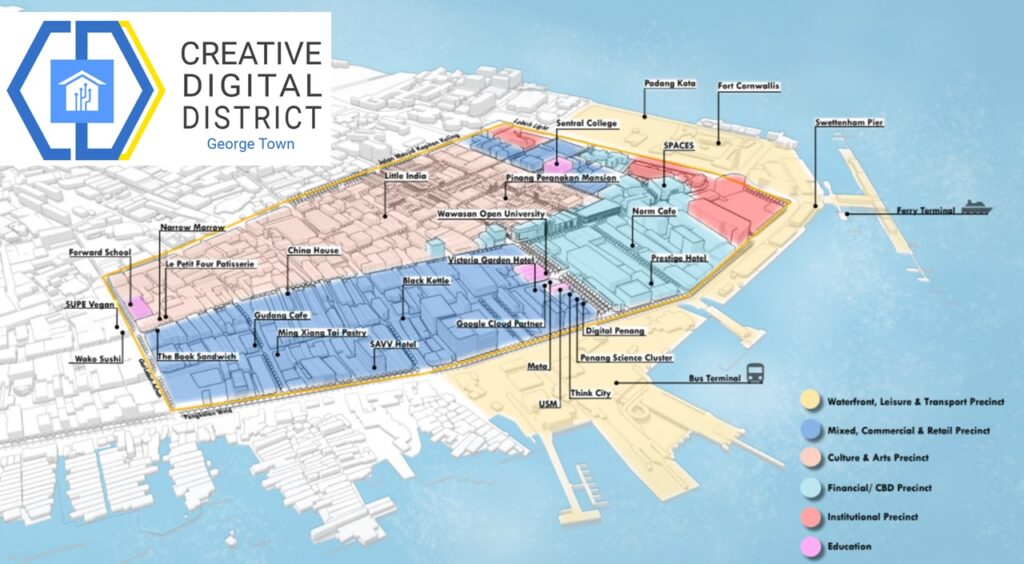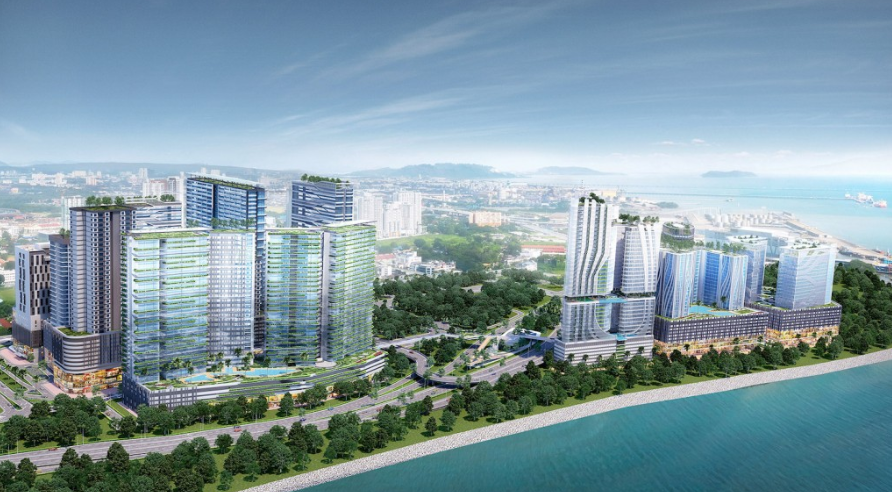The Creative Digital District (CD²@GeorgeTown) — Engineering the Next Phase in the Development of Penang
By Tony Yeoh
TECH WATCH
WITH AN IMPRESSIVE 50 years of industrialisation, Penang has carved itself a nickname as the Silicon Valley of the East. Today, the state has 10 industrial parks, making up a robust high-tech manufacturing ecosystem in semiconductors, medical devices, automotive electronics, avionics and many electrical and electronics related sectors. The other engine of Penang’s economy is more services-oriented and tourism-based; this suffered a bad hit during the pandemic over the last two years.
Despite this solid growth, the foreign direct investment (FDI) portfolio has focused only on manufacturing. This has not lifted the state’s median household income which still hovers at RM5,500 as of 2020, ranked 7th and slightly below the national average. About 40% of the workforce are in manufacturing making an average salary of RM3,500 while the remaining 60% are in semi-skilled sectors. Like much of the rest of the country, we are still very much a blue-collar workforce, competing on land and labour to attract foreign investments and likely very much stuck in the proverbial middle-income trap.
Bringing Penang2030 to Life
In line with the Penang2030 vision of a family-focused green and smart state, Digital Penang was set up as a government agency to spearhead and orchestrate initiatives towards digitalisation. A key pillar of the vision is to upgrade the economy to raise household incomes through upskilling and retention of talent. Given this backdrop, there is a need for a strategic imperative to develop the digital economy through upskilling the workforce and rebalancing the economic portfolio into more high-skilled knowledge-based services.
When Penang-founded banks, such as Ban Hin Lee Bank and Southern Bank, were acquired and merged into larger national banks, Penang lost jobs in the financial services sector. The setting up of Cyberjaya and the Multimedia Super Corridor initiated 25 years ago in the Klang Valley saw the growth of the information and communications technology (ICT) ecosystem. With the benefit of proximity to federal agencies such as MDEC and MaGIC, the tech startup ecosystem in the Klang Valley thrived over the last 10 years, further drawing away software and digital talents from Penang.
The digital wave is a pervasive current that will inevitably permeate all sectors in business and society. For Penang to be competitive going forward, we have to play at the intersection of hardware and software; even our manufacturing sector needs to go digital. Software-defined engineering skills will become increasingly critical if our manufacturing ecosystem is to prevail and persist.
Reviving the Urban Core
Against this backdrop of a weak services sector and the constant loss of talent, the State has made a strategic move to designate its first district dedicated to attracting investments in digital, software and creative services. To cultivate and retain such talent, the State needs to grow a tech startup incubation environment and attract investment beacons and anchors that will stem the outflow of software talent and create a stickier ecosystem. There is recognition that not everyone wants to work in a factory and not everyone wants to be an engineer in manufacturing.
Hence, the Creative Digital District (CD²@GeorgeTown) was started. It is dedicated to the revival of the central business district (CBD) in the UNESCO Heritage site as well as the creation of a digital services hub for Penang.
To be sure, many cities have rejuvenated and repositioned themselves as part of the post-pandemic economic recovery. For example, Newcastle aims to revive its economic performance by transforming one of its former industrial sites into a centre for collaborative, cross-sector activity. The Newcastle Helix, built on the site of the former Tyne Brewery located by St James’s Park football stadium at the edge of the city centre, is a new innovation district in Newcastle, designed to transform the district into a science and research hub.
Then there is BLOCK71 Singapore, a cluster of factory buildings located in the Ayer Rajah Industrial Estate of one-north, Singapore. It is home to more than 100 startups, venture capital firms and tech incubators. From this bustling entrepreneurial hub, property development in the area grew into the Fusionopolis and the Biopolis in the neighbourhood of National University of Singapore (NUS).
Inspired by such case studies, Penang aims to not only preserve the heritage character of the George Town UNESCO site but also focus on the economic sustainable development of the area. CD²@GeorgeTown (pronounced as CD Square at George Town) is a placemaking initiative to bring to life the Penang2030 vision of a “family-focused green and smart state” and is the first digital district of its kind in the state.

This first nucleus acts as a catalyst to spur innovation and attract investments in digital technology, software services, data centres, global business services and creative arts that will revive the urban core as a business district. We imagine it to evolve its heritage character into a city campus that will see the convergence of creative and digital activities to become a vibrant, liveable and sustainable environment where people can Live, Learn, Create and Play.
Two key elements are critical in developing this district. The first is infrastructure, especially for connectivity. Much of this is driven by the MCMC Jendela 5G plan for which the district will be the first area in Penang to have 5G deployed. The other critical factor is a liveable environment that attracts talents to come and live and work there. This will require policy changes and the support of private property owners and the local councils. Physical aesthetic dimensions need to be beautified to appeal to talents and nomads in creative and digital activities. Educational partners such as Wawasan Open University located along Gat Lebuh China, The One Academy and USM are key towards developing the area into a city campus.
Penang has been a good testbed environment for tech startups, such as JobStreet, Exabytes, PiktoChart and DeliverEat. Some of these have even successfully scaled internationally. The tech startup ecosystem in Penang is now growing with over 100 registered companies, six incubators and several special interest groups in game development, Google Developer Groups, Fintech, marketplaces, IoT, etc. With the support of federal agencies such as Cradle, MRANTI, MDEC and NCIA, many joint programmes will soon be launched to further generate more momentum.
Future Digital Districts
With this pioneering CD² district leading the state’s economic structural shift, it is envisaged that more private sector development of similar districts will emerge. Some examples of such developments are Sunshine Central and Straits City. The latter is a proposed 40-acre waterfront in Butterworth expected to be fully developed by 2038. A mixed development of retail, hospitality and commercial properties strategically located along Jalan Bagan Luar, adjacent to Taman Selat, it is only a few mere minutes’ drive to Penang Sentral, and under 15 minutes’ drive to the Penang Bridge. With development on both sides—George Town on the island and Butterworth on the mainland—the untapped value of Penang Bay will eventually be realised.

According to the 12th Malaysia Plan (12MP) released by the Economic Planning Unit (EPU) in 2021, the digital economy is expected to contribute 25.5% to the country's gross domestic product (GDP) by 2025.
There is no question that Penang has to drive digital adoption to create tech entrepreneurial markets and leverage digitalisation to upgrade its economic structure.
And the time is NOW!
Tony Yeoh

is the CEO of Digital Penang.



